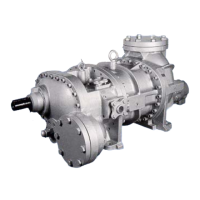REFRIGERATION DIVISION
V SERIES
SCREW COMPRESSOR HANDLING MANUAL
Supersedes all previous version. This information is for reference use only and subject to change without notice
Revision 2 (June 05,2000) Page 43 of 61
f) If the thrust bearing is being replaced with a new one, confirm that the end clearance of the
bearing is secured while loosening the bolt little by little. Since the difference in the side faces
of the inner and outer bearing races vary even if the bearing is within specifications, no
clearance is secured in some cases. If the nuts are tightly fastened from the beginning, in this
case the bearing balls will be pressed against the rolling contact surface and damaged.
If no clearance is secured, grind the thrust bearing gland (41) or replace the thrust adjusting
washer (42) with one or greater thickness.
If only a slight clearance is required, a thing plate may be affixed to the thrust adjusting
washer.
g) Press the rotor against the discharge end face with the inner race fixed to the rotor shaft.
h) The dial indicator mounted on the suction side rotor end must be set to the 0 position.
i) Fasten the thrust bearing-tightening washer (43) with the hex-head socket cap screw (45) and
hex-head bolt lock washer (46) and torque to the value given in the table below.
Compressor
Model
Fastening
Torque
160V** 400 kgf•cm
200V** 500 kgf•cm
250V** 600 kgf•cm
320V** 1200 kgf•cm
Fig. 89 Tightening Thrust Bearing Tightening Washer
If the end clearance is not within the appropriate range shown below, read just clearance
according to one of the methods explained later.
End Clearance (Discharge Side) (Unit: mm)
Booster (Low-Stage) Single-Stage
High-Stage
VS* VL* VM*
160V** 0.04~0.06 0.20~0.22 0.24~0.26 0.22~0.24
200V** 0.05~0.07 0.26~0.30 0.31~0.35 0.28~0.32
250V** 0.06~0.08 0.40~0.44 0.50~0.54 0.45~0.49
320V** 0.23~0.27 0.70~0.76 0.73~0.79 0.77~0.83
Fig. 90A Measuring End Clearance
j) End clearance adjustment method when measured value is not within specifications.
1) When end clearance is larger than the specified value.
This means that the distance of the rotor end face from the discharge end of the bearing head
is too large when the thrust bearing is secured with the gland. Various methods for reducing
the distance are available.

